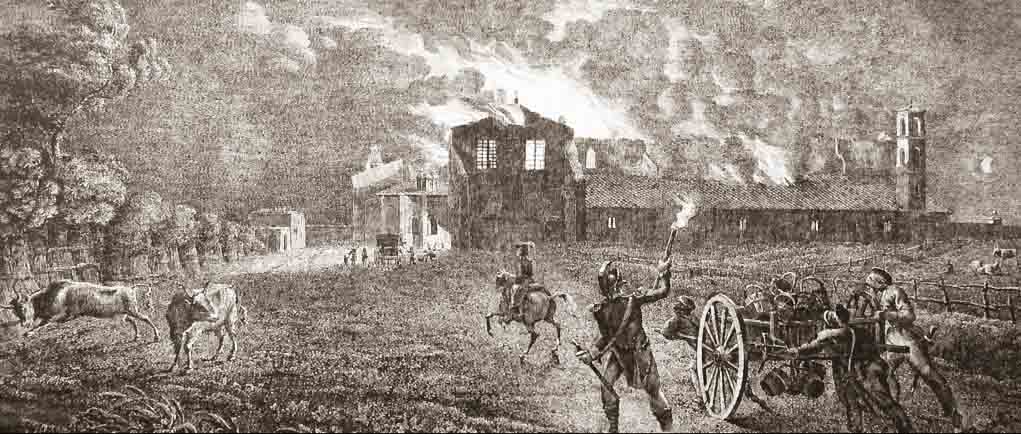1823 Fire of Sant Paul's Basilica

In the spring of 1823, the curate of St Paul outside the Walls pointed out that the construction of a large iron bracket to supporting some of the main beams of the roof that risked collapsing could no be extended longer, as well in the roof of the basilica there were still water infiltrations during the rains.
In July of the same year he was given the task of repairing the roof and the gutters and, as we read in the chronicle of the accident, two tinmen after they had finished ... placing the copper channels on the eaves of the roof of the large nave, located at west ...
as it was already night they stopped their work to go home leaving the pan on the roof with the embers that thought they had turned off.
Probably, a light wind was enough to make the pan overturn and the embers not completely extinguished fell on the roof reaching the wooden beams that caught fire.
The bulletin of Rome of 16 July reports the fire broke out just hours before dawn and the first to see it was a herdsman was watching the cows grazing on the lawn under the monastery walls. The man ran to warn the farmer of the Cassinesi monks who had been entrusted with the care of the Basilica.
The alarm was given by two clerics who after having tried in vain to stem the fire with the greatest risk of their lives, went to the bell tower to ring the hammer bells, in order to solicit help ...
.
The great delay with which fire was noticed was due to the fact that during the summer the monks moved to the palace of San Callisto in Trastevere to escape the sultry and malaria-friendly climate along Ostiense way countryside. The monks arrived at the Basilica only at nine in the morning. The firemen had meanwhile left their barracks in the square of St. Ignatius with three horse carriages, two of which carried fire pumps while the third was loaded with various tools. When the firefighters arrived at the site, they found the papal dragons who controlled the area to prevent malicious get taken advantage of it. The firemen understood that the fire was now unstoppable, however they managed to cut the fire on the side towards the monastery which in this way they managed to save.
The flames continued for five hours and in the end not only was the wooden roof burned but the falling of the tiles caused the collapse of middle nave walls and of some columns. The damage to the basilica was enormous; the bronze door that came from Constantinople "melted along the fiery ground" while, of the 40 columns of the central nave, the central ones of the left side fell to the ground dragged by the weight of the wall on which the tiles had fallen once the beams were burned.
The entire left side of the basilica had serious damage to both the middle and outer aisles, while the middle aisles to the right had much less serious damage and fortunately they were not hit by fire, the columns of the transept were saved and the ciborium of Arnolfo di Cambio was safe also.
Chronicles say that the smoke was still visible fifteen miles away.
Although the fire immediately appeared "culpable" and attributable to the carelessness and superficiality of the two workers, many other causes were indicated in the lounges and squares of Rome: it could have been caused by an attack by the "carbonari" - the revolutionaries who fought to remove Rome from the temporal power of the Popes - or the Jews had been or a conspiracy of the "subversive" banker Rothschild existing in Rome in those days, but there were someones did not rule out a divine punishment for an increasingly secular city that had to be brought back to "fear of God".
There were many artists of the time who rushed to draw the ruin of the great Basilica and among them also the engraver Luigi Rossini who drew four drawings from different points of view that were spread all over the world ...
Sign up and read the rest of the article!
by M.L. ©ALL RIGHTS RESERVED (Ed 1.0 - 21/09/2020)






